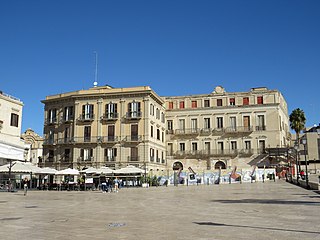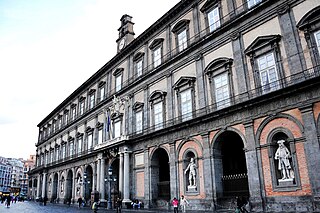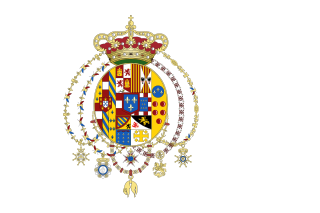Related Research Articles

Bari is the capital city of the Metropolitan City of Bari and of the Apulia region, on the Adriatic Sea, southern Italy. It is the second most important economic centre of mainland Southern Italy after Naples. It is a port and university city, as well as the city of Saint Nicholas. The city itself has a population of 315,284 inhabitants, and an area of over 116 square kilometres (45 sq mi), while the urban area has 750,000 inhabitants. The metropolitan area has 1.3 million inhabitants.

Ferdinand I was King of the Two Sicilies from 1816 until his death. Before that he had been, since 1759, King of Naples as Ferdinand IV and King of Sicily as Ferdinand III. He was deposed twice from the throne of Naples: once by the revolutionary Parthenopean Republic for six months in 1799, and again by a French invasion in 1806, before being restored in 1815 at the end of the Napoleonic Wars.

The Kingdom of Naples, was a state that ruled the part of the Italian Peninsula south of the Papal States between 1282 and 1816. It was established by the War of the Sicilian Vespers (1282–1302), when the island of Sicily revolted and was conquered by the Crown of Aragon, becoming a separate kingdom also called the Kingdom of Sicily. This left the Neapolitan mainland under the possession of Charles of Anjou. Later, two competing lines of the Angevin family competed for the Kingdom of Naples in the late 14th century, which resulted in the death of Joanna I by Charles III of Naples. Charles' daughter Joanna II adopted King Alfonso V of Aragon as heir, who would then unite Naples into his Aragonese dominions in 1442.

The Neapolitan War, also known as the Austro-Neapolitan War, was a conflict between the Napoleonic Kingdom of Naples and the Austrian Empire. It started on 15 March 1815, when King Joachim Murat declared war on Austria, and ended on 20 May 1815, with the signing of the Treaty of Casalanza. The war occurred during the Hundred Days between Napoleon's return from exile and before he left Paris to be decisively defeated at the Battle of Waterloo. The war was triggered by a pro-Napoleon uprising in Naples and ended with a decisive Austrian victory at the Battle of Tolentino, after which Bourbon monarch Ferdinand IV was reinstated as King of Naples and Sicily. However, the intervention by Austria caused resentment in Italy, which further spurred on the drive towards Italian unification.

Southern Italy, also known as Meridione or Mezzogiorno, is a macroregion of Italy consisting of its southern regions.

The Battle of Tolentino was fought from 2–3 May 1815 near Tolentino, Kingdom of Naples in what is now Marche, Italy: it was the decisive battle in the Neapolitan War, fought by the Napoleonic King of Naples Joachim Murat to keep the throne after the Congress of Vienna. The battle occurred during the Hundred Days following Napoleon's return from exile and, like the Battle of Waterloo, resulted in a decisive victory for the Seventh Coalition, leading to the restoration of the previous Bourbon king, Ferdinand I.

The Expedition of the Thousand was an event of the unification of Italy that took place in 1860. A corps of volunteers led by Giuseppe Garibaldi sailed from Quarto al Mare near Genoa and landed in Marsala, Sicily, in order to conquer the Kingdom of the Two Sicilies, ruled by the Spanish House of Bourbon-Two Sicilies. The name of the expedition derives from the initial number of participants, which was around 1,000 people.

Andria is a city and comune (municipality) in the Apulia region of Southern Italy. It is an agricultural and service center, producing wine, olives and almonds. It is the fourth-largest municipality in the Apulia region and the largest municipality of the province of Barletta-Andria-Trani. It is known for the 13th-century Castel del Monte.

Adelfia is a town and comune in the Metropolitan City of Bari, Apulia, southern Italy. The town is 18 km (11 mi) south of central Bari, and is a combination of two smaller towns, Montrone and Canneto.

The Royal Palace of Naples is a palace, museum, and historical tourist destination located in central Naples, southern Italy.

San Francesco di Paola is a prominent church located to the west in Piazza del Plebiscito, the main square of Naples, Italy. The construction started in 1816 and ended in 1846.

The Battle of the Panaro was a victory for King Joachim Murat's Neapolitan forces over a smaller Austrian force under Frederick Bianchi on 3 April 1815 early in the Neapolitan War. This defeat on the banks on the Panaro River, just south of Modena forced the Austrians to retreat behind the Po River.
The Battle of Scapezzano was a short engagement during the Neapolitan War on 1 May 1815 between an Austrian corps under Adam Albert von Neipperg and a Neapolitan division under Michele Carrascosa.

The Battle of San Germano was the final battle in the Neapolitan War between an Austrian force commanded by Laval Nugent von Westmeath and the King of Naples, Joachim Murat. The battle started on 15 May 1815 and ended on 17 May, after the remaining Neapolitan force was routed at Mignano.

The Kingdom of the Two Sicilies was a kingdom in Southern Italy from 1816 to 1861 under the control of a cadet branch of the Spanish Bourbons. The kingdom was the largest sovereign state by population and land area in Italy before the Italian unification, comprising Sicily and most of the area of today's Mezzogiorno and covering all of the Italian Peninsula south of the Papal States.
The Battle of Mileto took place during the War of the Third Coalition on 28 May 1807 in Calabria. The Bourbon Kingdom of Sicily attempted to re-conquer its possessions in continental Italy, known as the Kingdom of Naples. The battle ended in a victory for French forces under general Jean Reynier.

The Kingdom of Naples was a French client state in southern Italy created in 1806 when the Bourbon Ferdinand IV & III of Naples and Sicily sided with the Third Coalition against Napoleon and was in return ousted from his kingdom by a French invasion. Joseph Bonaparte, elder brother of Napoleon I, was installed in his stead: Joseph conferred the title "Prince of Naples" to be hereditary on his children and grandchildren. When Joseph became King of Spain in 1808, Napoleon appointed his brother-in-law Joachim Murat to take his place. Murat was later deposed by the Congress of Vienna in 1815 after striking at Austria in the Neapolitan War, in which he was decisively defeated at the Battle of Tolentino.

The Army of the Kingdom of Naples was the primary land defence and offence force of the Kingdom of Naples. It served alongside Napoleon’s Grande Armée in various campaigns and wars across Europe, until its final demise in the Neapolitan War of 1815. It was in service from 1806 to 1815, reborn from the Army of the Two Sicilies after the annexation of Naples. The Army was more known for the splendour of its uniforms rather than the achievements of its troops.